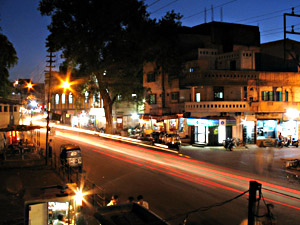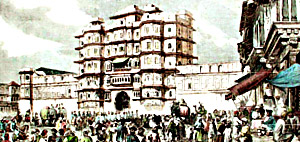History of Indore dates back to almost 18th century and reflects the prejudices of Holkar dynasty. Indore is presently the largest city and the commercial capital of the central Indian state of Madhya Pradesh; its present location is on the Malwa Plateau, just north of the Vindhya Range.
 The ancient history of Indore narrates the ancestors or the founders of Indore to be the hereditary Zamindars and indigenous landholders (Jehangirdars) of Malwa. In Mughal times, the founders of these families were honoured with the titles such as Singh and Chaudhari, which established their control over the land. In the 18th century, control of Malwa passed to the Peshwa clan, and the Chaudharis came to be known as "Mandloi"s that was derived from Mandals, owing to the language they used and eventually the Holkars bestowed the family with the title of singh Raja. The family retained its belongings of royalty, which included having an elephant, Nishan, Danka and Gadi even after the arrival of Holkars and also retained the power of performing the first puja of Dushera (Shami Pujan) before the Holkar rulers.
The ancient history of Indore narrates the ancestors or the founders of Indore to be the hereditary Zamindars and indigenous landholders (Jehangirdars) of Malwa. In Mughal times, the founders of these families were honoured with the titles such as Singh and Chaudhari, which established their control over the land. In the 18th century, control of Malwa passed to the Peshwa clan, and the Chaudharis came to be known as "Mandloi"s that was derived from Mandals, owing to the language they used and eventually the Holkars bestowed the family with the title of singh Raja. The family retained its belongings of royalty, which included having an elephant, Nishan, Danka and Gadi even after the arrival of Holkars and also retained the power of performing the first puja of Dushera (Shami Pujan) before the Holkar rulers.
Under Mughal rule, these families enjoyed great influence and were accorded confirmatory sanads by the Emperors Aurangzeb Alamgir and Farukhshayar, confirming their `Jagir` powers. Rao Nandlal Chaudhary Zamindar, upon visiting the court of Delhi, received a special seat in the emperor`s court along with two jewel-studded swords, which are now at display in the Royal British Museum under the family`s name. Raja Savai Jai singh of Jaipur gifted him with a special "Gold Langar" which ascertained a special place to him in all the Durbars of India. The family`s decency and influence over Malwa was influential in the rise of the Peshwas and Holkars to leadership of this region.
Rao Nandlal Chaudhary is the prime name in the history of Indore. He was the founder of Indore, the Chief Zamindar and had an army of 2000 soldiers. In 1713, Nizam was appointed as the controller of the Deccan plateau area, which started the struggle between the Marathas and the Mughals. From time to time the Maratha invaders kept distressing the people of Malwa and thus Nandlal singh arranged to pay 25000 rupees to them in return for undertaking the safety and security of his people, upon which the invaders returned back to the Deccan.
Nandlalsingh found the location of Indore to be safe and strategic, while visiting the temple of Indreshwar near the banks of river Saraswati. He started moving his people in, constructed the fort of Shree Sansthan Bada Rawala and protected them from harassment by Marathas and Mughals. The city was named Indrapur (after Lord Indreshwar), and eventually came to be known as Indore. Baji Rao Peshwa finally received the Viceroyalty of Malwa in 1743 A.D. and was acknowledged by a treaty forbidding him from ever infringing upon the rights of Zamindars. Malhar Rao Holkar was one of the four eminent personalities who guaranteed the proper fulfillment of the conditions. Upon victory the Peshwas appointed Malhar Rao Holkar as a "Subhedar", which marked the beginning of Holkars` reign in Malwa.

As a result of this defeat in the Battle of Mahidpur, the treaty of Mandsaur was signed and the Cantonment town of Mhow was ceded to the British. The treaty also stated that the capital of the Holkar state would shift from Maheshwar to Indore.
After India`s independence in 1947, the modern history of Indore began along with a number of neighboring princely states that became part of the Indian state of Madhya Bharat. Indore was declared as the summer capital of this newly created state. On November 1, 1956, Madhya Bharat was fused into Madhya Pradesh and Bhopal selected the capital. The city palace was made the seat of administration of the rulers of the Malwa region - The Holkars. The Rajbada was burnt during the 1984 riots, and thus converted into a garden till 2006 when the present Maharani of Indore, H.H Ushadevi Holkar, decided to re construct the wada to its past glory. H.H Ushadevi Holkar invited architects Himanshu Dudwadkar and Shreya Bhargava to design the upcoming project and in 2007 the Rajwada found its place back in the history of Indore. Indore became the only historic structure in India to have been rebuilt with exactly the same style and poise, materials and method of construction as those of 250 years ago.



















